Archives
- Ms. Naomi Aoki: Ph.D. student at The Maxwell School of Citizenship and Public Affairs at Syracuse University (Department of Public Administration);
- Ms. Nikola Sander: Ph.D. student at the School of Geography, Planning and Architecture, The University of Queensland, Brisbane, Australia; and
- Mr. Edward Spang: Ph.D. student at the Fletcher School
News & Highlights of 2008
Election to the Austrian Academy of Sciences
In 2008 Wolfgang Lutz was elected as a corresponding member (kMI) of the Austrian Academy of Sciences.

Leader of IIASA's World Population Program, Professor Wolfgang Lutz, has been awarded the inaugural Advanced Investigator Grant of the European Research Council. The ambitious study, “Forecasting societies’ adaptive capacity to climate change”, has been granted approximately 2.5 million Euros over five years to address a key knowledge gap concerning the likely impact of climate change on human wellbeing. ![]() More
More
Click for detailed
Data Sheets Below:
News & Highlights of 2007
MicMac Meeting on Assumptions on Future Mortality and Morbidity Trends in Europe
September 10 - September 11, 2007
Location: IIASA, Laxenburg, Austria
Organizer(s):
Wolfgang Lutz (IIASA)
Frans Willekens (NIDI)
N.L. van der Gaag (NIDI)
 Agenda and list of participants
Agenda and list of participants
(Posted Sep 2007)
 The World Population Program welcomes Victor Garcia Guerrero. Victor received a BSc. degree in actuary and an M.Eng. degree in operations research, both from the Universidad Nacional Autonoma de Mexico (UNAM). He has a diploma in advanced econometrics from the Faculty of Economics at UNAM and has also taught econometrics at the Faculty of Sciences.
He is currently working on his PhD in population studies at El Colegio de Mexico A.C. His dissertation is about population projections and policies in Mexico, undertaking a critical review of the official population projections and developing an alternative probabilistic methodology.
The World Population Program welcomes Victor Garcia Guerrero. Victor received a BSc. degree in actuary and an M.Eng. degree in operations research, both from the Universidad Nacional Autonoma de Mexico (UNAM). He has a diploma in advanced econometrics from the Faculty of Economics at UNAM and has also taught econometrics at the Faculty of Sciences.
He is currently working on his PhD in population studies at El Colegio de Mexico A.C. His dissertation is about population projections and policies in Mexico, undertaking a critical review of the official population projections and developing an alternative probabilistic methodology.
Mr. Garcia Guerrero joined the World Population Program in September 2007 to develop a probabilistic methodology to project the Mexican population. His main academic interests are: formal demography, mathematical modeling, population policy making, and historical demography.
(Posted Sep 2007)
Welcome Young Scientists: Fifty-one post-graduate students from 20 countries have arrived at IIASA for our annual Young Scientists Summer Program. In the next three months, senior scientists will guide the young scholars as they pursue their chosen research topics. The program offers a unique opportunity for them to enhance their research skills and become part of a worldwide network of interdisciplinary and cross-cultural specialists.
The World Population Program welcomes
[more details about the YSSPers]
(Posted June 2007)
Population Association of America (PAA)
2007 Annual Meeting, New York, NY, March 29-31
P-3F METHODS AND APPLIED DEMOGRAPHY
63 Reconstruction of Populations by Age, Sex and Level of
Educational Attainment for 120 Countries for 1970-2000 Using Demographic Back-Projection
Methods • Wolfgang Lutz (IIASA); Samir KC, IIASA; Anne Goujon
(VID and IIASA)
WINNING POSTER
102 NEW PERSPECTIVES ON LOW FERTILITY
3 New Empirical Evidence on the Low Fertility Trap Hypothesis • Wolfgang
Lutz (IIASA), and Vegard Skirbekk (IIASA)
P-7H GENDER, RACE/ETHNICITY, RELIGION
70 New Times, Old Beliefs: Projecting the Future Size of
Religions in Austria, Canada and Switzerland • Anne Goujon (VID
and IIASA); Vegard Skirbekk (IIASA); Katrin Fliegenschnee (VID)
(Posted April 2007)
The World Population Program welcomes Emma Terämä.
Emma Terämä received her Doctor of Science degree in technology from the Helsinki University of Technology in 2007. She concentrated on atomistic modeling and supercomputing of biological systems such as cell membranes. She was an Erasmus-scholar at the Freie Universität in Berlin during her master's studies, and a Research Scholar at the University of California at Davis in between her PhD studies.
Dr. Terämä's interest in sustainable development projects
arouse during 11 years of UNICEF-work and chairing the Helsinki volunteer
group. She is using the modeling experience gathered during her physicist
years and applying it to demography. The issues that interest her the
most pertain to AIDS and other globally important health topics, education,
and local human-environment interactions.
(Posted April 2007)
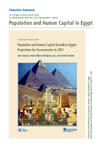 IIASA’s World
Population Program and the Cairo
Demographic Center have finished a study on projecting
future population and human capital growth at the level of governorates
in Egypt. Their findings were presented March 7th at a symposium at the Egyptian Academy
of Scientific Research and Technology.
IIASA’s World
Population Program and the Cairo
Demographic Center have finished a study on projecting
future population and human capital growth at the level of governorates
in Egypt. Their findings were presented March 7th at a symposium at the Egyptian Academy
of Scientific Research and Technology.
Executive summary (PDF): High resolution -- Low resolution (fax print quality)
Project Report (PDF): Anne Goujon, Huda Alkitkat,
Wolfgang Lutz, and Isolde Prommer. Population
and Human Capital Growth in Egypt:
Projections for Governorates to 2051. Laxenburg, Austria: IIASA Interim Report
IR-07-010 [March 2007, 116 pp]
(Posted March 2007)
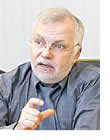 February 2007: Sergei
Scherbov gave an interview in the central and
most influential Belorussian newspaper Belarus Today. During his last
trip to Minsk, Sergei gave a presentation to parlament members and represenantives
of executive power describing the future of their population. There were
plenty of interviews, TV and radio programs devoted to this event. This
interview, with reference to IIASA, is a central one : sb.by/print.php?articleID=56829
February 2007: Sergei
Scherbov gave an interview in the central and
most influential Belorussian newspaper Belarus Today. During his last
trip to Minsk, Sergei gave a presentation to parlament members and represenantives
of executive power describing the future of their population. There were
plenty of interviews, TV and radio programs devoted to this event. This
interview, with reference to IIASA, is a central one : sb.by/print.php?articleID=56829
(Posted Feb 2007)
Jesus Crespo Cuaresma & Wolfgang
Lutz
Human Capital, Age Structure,
and Economic Growth
World Population Seminar - 16 January 2007
![]() Slides
[PPT]
Slides
[PPT] ![]() Listen
[MP3 1:01:06]
Listen
[MP3 1:01:06]
Seminar Summary
In collaboration with the Vienna Institute of Demography, IIASA's World Population Program has developed a new dataset of educational attainment by age and sex for 120 countries for the period 1970–2000. The consistency of this new data is superior to existing historical datasets which have many gaps in time and changes in definition. Further, the new dataset also adjusts past enrollment rates as they are influenced by the different mortality rates that vary with people's level of education.
By exploiting the demographic dimension of the education data, the researchers show human capital is better able to explain differences in income per capita across countries. In addition, when using the new data, aggregate changes in educational attainment are a robust determinant of economic growth. This unique data collection also provides a deeper insight into the importance of the age structure of human capital in technology adoption.
More about the speaker at IIASA's Publications Department website
Or W.
Lutz's CV and J.C.Cuaresma's biography
![]() To
subscribe to IIASA Podcasts, copy and paste the following address into
your podcasting software: http://www.iiasa.ac.at/Publications/podcast/iipod.xml
To
subscribe to IIASA Podcasts, copy and paste the following address into
your podcasting software: http://www.iiasa.ac.at/Publications/podcast/iipod.xml
(Posted Jan 2007)
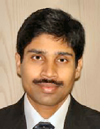 The World Population Program welcomes Tapas
MISHRA: Before joining the
IIASA's Postdoctoral
Program, Tapas Mishra completed his
doctoral
research
in economics
specializing
in macroeconomics,
demography and non-stationary econometrics from Catholic
University of Louvain, Belgium. Mr. Mishra's research focuses on
studying consequences of stochastic demographic system on economic growth
and development by
exploiting their
non-stationary temporal and spatial features. Over the past years he
has specialized in the empirics of economic growth and has also worked
on demographic and demography-based income projections, and the study
of variations of cross-country economic growth by introducing stochastic
environment, demography and economic growth system. He has had several
years of experience in working for international and national economy
policy making bodies. Check his CV for a detailed list of publications and areas of research.
The World Population Program welcomes Tapas
MISHRA: Before joining the
IIASA's Postdoctoral
Program, Tapas Mishra completed his
doctoral
research
in economics
specializing
in macroeconomics,
demography and non-stationary econometrics from Catholic
University of Louvain, Belgium. Mr. Mishra's research focuses on
studying consequences of stochastic demographic system on economic growth
and development by
exploiting their
non-stationary temporal and spatial features. Over the past years he
has specialized in the empirics of economic growth and has also worked
on demographic and demography-based income projections, and the study
of variations of cross-country economic growth by introducing stochastic
environment, demography and economic growth system. He has had several
years of experience in working for international and national economy
policy making bodies. Check his CV for a detailed list of publications and areas of research.
(Posted Jan. 2007)
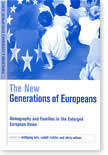 The New Generations of Europeans
The New Generations of Europeans
Demography and Families in the Enlarged European Union
Edited by Wolfgang Lutz, Rudolf Richter and Chris Wilson, © IIASA
and Earthscan 2006
About
the Editors
Table
of Contents
Ordering
Information
Book
link at publisher
From the series "Population and Sustainable Development," providing
fresh ways of thinking about population trends and impacts.
Europe today is characterized by aging populations, changing family patterns, dropping fertility rates and mass migration. With the potentially massive ramifications this has for pensions, health, housing, transport, family relations, employment and other sectors of society, The New Generations of Europeans sets out to assess what it is to be a citizen of a growing EU and what important demographic, social, and economic issues will have to be faced by European decision makers. Edited by leading demographers and sociologists, and made up of contributions from respected researchers in the fields of population and society from different parts of Europe, it presents the results of five years of research by the European Observatory on the Social Situation, Demography and the Family.
With the aid of over 100 graphs and tables and a full discussion, this book
asks how numerous, fertile and long-lived the new generations of European citizens
will be. The state of families, immigration and health are all examined, especially
in the context of the challenges that will be faced in maintaining social cohesion.
Crucially, the question of how demographic changes will impact Europe’s
socioeconomic infrastructure is woven throughout.
(Posted Nov. 10, 2006)
 Despite
the current problems with European integration,
younger Europeans tend to have a European identity in addition to their national
one. So concluded IIASA demographers Wolfgang
Lutz (also of the Austrian Academy
of Sciences) and Vegard
Skirbekk together with Sylvia
Kritzinger of the Institute of Advanced
Studies after studying Eurobarometer data. See POPNET for
a reprint from Science.
Despite
the current problems with European integration,
younger Europeans tend to have a European identity in addition to their national
one. So concluded IIASA demographers Wolfgang
Lutz (also of the Austrian Academy
of Sciences) and Vegard
Skirbekk together with Sylvia
Kritzinger of the Institute of Advanced
Studies after studying Eurobarometer data. See POPNET for
a reprint from Science.
(Posted Oct. 2006)
EUROPE is the theme of the new POPNET newsletter
 The
Forces Driving Unprecedented Population Ageing
The
Forces Driving Unprecedented Population Ageing
° European Demographic Data Sheet 2006
° Tempo Effect and Adjusted TFR
° Range of Likely Future Trends in the EU-25
Reprint from Science:
° The Demography of Growing European Identity (Supporting Online Material.
This supplement contains: Introductory Text / Materials and Methods / Tables
A1 to A4 / References.
Download supplement at Science (PDF)
or at IIASA (PDF)
The New Generations of Europeans
Download POPNET No.
38, Autumn 2006 (PDF)
(Posted Oct. 2006)
 The
World Population Program welcomes Jesus
Crespo Cuaresma. Jesus will work on a new project on Human Capital and
Economic Growth.
The
World Population Program welcomes Jesus
Crespo Cuaresma. Jesus will work on a new project on Human Capital and
Economic Growth.
Email: crespo@iiasa.ac.at
Jesus Crespo Cuaresma holds a doctorate in economics from the University of
Vienna, as well as a second doctorate (Habilitation) in economics from the
same University. He is an associate professor at the Department of Economics
of the University of Vienna and a scientific advisor to the Österreichische
Nationalbank. He is working on applied macroeconometrics, economic growth,
forecasting, business cycle research, and monetary and fiscal policy. He has
published numerous articles on such issues in refereed scientific journals
and books.
(Posted Sep. 2006)
7. September 2006
Symposium of the NÖ Landesakademie
Theme: „Europa, der alternde Kontinent“ (Europe theaging continent)
(Posted Sep. 2006)
 IIASA
at the European Population Conference 2006
IIASA
at the European Population Conference 2006
The "European Population Conference 2006" was organized by the "European Association for Population Studies". This international conference took place this year in Liverpool from the 21th until the 24th June and was entitled: "Population Challenges in Ageing Societies ".
Scientists of IIASA's World Population Program presented the following papers:
Session 16: Bridging the micro-macro
gap in forecasting. Where do assumptions come from?: Investigating the substantive
basis for population projections in Europe.
Wolfgang Lutz, International
Institute for Applied Systems Analysis (IIASA) & Vienna Institute of Demography
(VID); Samir K.C., IIASA; Isolde Prommer,
IIASA; Christopher Wilson, IIASA
Session 57: Managing regular and irregular migration. Chair: Wolfgang Lutz, IIASA & VID
Session 66: New Times, Old Beliefs: Predicting the Future of Religions in Austria (2001-2051). Anne Goujon, VID & IIASA; Vegard Skirbekk, IIASA; Katrin Fliegenschnee, VID; Pawel Strzelecki, Warsaw School of Economics
Session 73: A New Effort to Reconstruct
the Population by Age, Sex and Level of Education for all Countries since
1970.
Samir KC, IIASA; Anne
Goujon, VID & IIASA; Wolfgang Lutz, IIASA & VID
(Posted July 2006)
 A
comprehensive demographic data sheet (poster) for 46
European countries shows newly computed fertility indicators and projections.
It is the work of IIASA's World Population
Program in collaboration with the Vienna
Institute of Demography of the Austrian
Academy of Sciences and the Population
Reference Bureau.
A
comprehensive demographic data sheet (poster) for 46
European countries shows newly computed fertility indicators and projections.
It is the work of IIASA's World Population
Program in collaboration with the Vienna
Institute of Demography of the Austrian
Academy of Sciences and the Population
Reference Bureau.
Ask for a free copy.
(Posted June 2006)
 Welcome
Young Scientists
Welcome
Young Scientists
Forty-nine post-graduate students from 18 countries arrived at IIASA on Thursday,
June 1st for IIASA's 2006
Young Scientists Summer Program (pdf). During the next three months, senior
scientists will guide the students as they pursue their chosen research topics.
The World Population welcomes Marcin
Stonawski from the Department of Demography at Cracow University of Economics,
Poland.
(Posted June 2006)
 Apply
Now for IIASA's Postdoctoral Program
Apply
Now for IIASA's Postdoctoral Program
IIASA's post-doctoral program. Click for details.We are now accepting applications
for our annual postdoctoral program. Each year IIASA selects two post-graduate
researchers to receive full funding for a 12-24 month stay at IIASA. The application
deadline is August 15th, 2006. Details. Application
form.
(Posted May 2006)
 Tomorrow's
People: the Challenges of Technologies for Life Extension and Enhancement
Tomorrow's
People: the Challenges of Technologies for Life Extension and Enhancement
Logo of James Martin Institute. Click to enlarge. On March 17th, Wolfgang Lutz
of IIASA's Population Program addressed the first Global
Forum on Tomorrow's
People: the Challenges of Technologies for Life Extension and Enhancement at
the James
Martin Institute of the University of Oxford, UK. See and hear his talk
on Global Population Ageing and the World's
Future Human Capital (Requires Real Player. Lutz begins speaking 10 minutes
into the video).
(Posted March 2006)
 Asia:
Critical Issues for a Sustainable Future
Asia:
Critical Issues for a Sustainable Future
IIASA’s World Population Program is co-organizing an International
Conference on Population and Development in Asia, planned
for 20-22 March in Phuket, Thailand. The event will mark the end of the
first six-year program of the Asian
MetaCentre for Population and Sustainable Development Analysis, which
is being funded as a Regional Centre of Excellence by the Wellcome
Trust.
(Posted March)
 The
World Population welcomes Joze Sambt.
The
World Population welcomes Joze Sambt.
Joze Sambt is a teaching assistant at the Faculty of Economics, University
of Ljubljana, Slovenia. He graduated and finished his master's degree at that
faculty and is currently a PhD candidate. He joined the World Population Program
in February 2006 as a Guest Research Scholar.
(Posted March 2006)
Europe Faces Demographic
Challenges
In the context of Austria's
EU presidency, a high-level conference on Demographic
Challenges was held in the Vienna Hofburg February 1-2. At the meeting,
Wolfgang Lutz, leader of IIASA’s World
Population Program, presented a summary of the demographic challenges confronting
Europe and chaired the concluding panel discussion.
(Posted January)
 The
World Population welcomes Sarah
Staveteig (University of California at Berkeley, USA)
The
World Population welcomes Sarah
Staveteig (University of California at Berkeley, USA)
Peccei Scholar, January - March 2006
Sarah was chosen for her work on the issue of "Relative Cohort Size
and the Risk of Civil War, 1961-2001".
(Posted January)
Oct 2005: Asia is the theme of the new POPNET newsletter (pdf) from IIASA's World Population Program
- The "Asian Century" Will Be Based on Human Capital
- Population-Environment Interactions in Coastal Areas of Asia after the Tsunami
- Update from the Asian MetaCentre
- Reprint from Nature: Average Remaining Lifetimes Can Increase Human Populations Age
- International Meeting on "Postponement of Childbearing in Europe"
- Asian MetaCentre Conference on "Population and Development in Asia: Critical Issues for a Sustainable Future"
 Sept
2005: The World Population Program welcomes Mr. Joshua
R. Goldstein
Sept
2005: The World Population Program welcomes Mr. Joshua
R. Goldstein
Joshua R. Goldstein is associate professor of sociology and public affairs at Princeton University and a faculty associate of Princeton's Office of Population Research. He is on leave at IIASA for one year. He holds a Ph.D. in Demography from the University of California at Berkeley (1996). He has worked in family demography, the demography and mixing of ethnic groups, aging, and mathematical demography. His current project, the Changing Ages of Man, is a comparative, historical project on longevity and the human life course.
July 2005: A ministerial-level conference in Brussels July 11–12 addressed demographic challenges facing the European Union.
 This was the first meeting at this level to explicitly deal with the issues
of how policy could influence demographic trends. The conference rapporteur
was Wolfgang Lutz, leader of IIASA's World Population Program.
This was the first meeting at this level to explicitly deal with the issues
of how policy could influence demographic trends. The conference rapporteur
was Wolfgang Lutz, leader of IIASA's World Population Program.
 July
2005:
July
2005:
Sanderson,
W.C. and Scherbov, S. 2005. Average Remaining Lifetimes Can Increase
as Human Populations Age. Nature, 345:811-813
In the issue 345 of Nature,
researchers Warren Sanderson and Sergei Scherbov of IIASA's World
Population Program suggest a new perspective on population ageing and the
sustainability of pension systems in countries like the US, Germany and Japan.
As remaining life expectancy increases, people remain relatively young for
longer. A gradual increase in retirement age, they suggest, might be fairer
and more sustainable than current pension systems, which favors older generations. Press
release (pdf). More.
(Posted June 2005)
IIASA Reprint RP-05-006:
The article can be order at the Publication
Department for a handling charge of $10.00.
June 2005: The World Population Program warmly welcomes five participants of IIASA's Young Scientist Summer Program 2005:
Mr. Jean-Christophe Fotso, Mr. Frederick Mugisha, and Mr. Zewdu Woubalem from the African Population and Health Research Center (APHRC) in Nairobi, Kenya; Ms. Ying Ji from the Institute of Population Research at the Peking University, China; and Mr. Pawel Strzelecki from the Institute of Statistics and Demography at the Warsaw School of Economics, Poland. Click here to read their Biographical Sketches
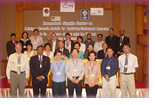 May
2005:
May
2005:
Population-Environment
Interactions in Coastal Areas of Asia after the Tsunami
A scientific seminar was held in Phuket 9-11 May 2005, to define the joint research program of population-environment interactions in the coastal regions of Asia after the tsunami of the Asian MetaCentre for Population and Sustainable Development Analysis and IIASA (see earlier posting).
 May
2005: The
World Population Program welcomes Mr. Samir
K.C.
May
2005: The
World Population Program welcomes Mr. Samir
K.C.
Mr. K.C. is currently in the PhD program at the University of Groningen, the Netherlands, where he is mainly developing a multi-disease multi-state population model for lung diseases for the economic evaluation of the pilot implementation of the "Practical Approach to Lung Health" initiative of the WHO in Nepal.
 April
2005: The UNESCO
Institute of Statistics recently abandoned its old methodology for literacy
projections and adopted instead the multi-state population projection approach
developed at IIASA. Wolfgang
Lutz and Anne
Goujon of IIASA's World Population Program use the approach
when forecasting population by age, sex and level of education for all
countries of the world.
April
2005: The UNESCO
Institute of Statistics recently abandoned its old methodology for literacy
projections and adopted instead the multi-state population projection approach
developed at IIASA. Wolfgang
Lutz and Anne
Goujon of IIASA's World Population Program use the approach
when forecasting population by age, sex and level of education for all
countries of the world.
April 2005: Press Clipping: New
light on Egypt's future by John Rowley (People & the Planet).
Click on the link for more information on the PDE project Population,
Human Capital and Water in Egypt by IIASA's World
Population Program.
 March
2005: The
World Population Program welcomes Moema
Figoli.
March
2005: The
World Population Program welcomes Moema
Figoli.
Dr. Figoli is a demographer and teaches at the University Federal de Minas Gerais in Belo Horizonte, Brazil, where she received her Ph.D. in demography in 1997. From September 1994 to September 1995, she worked on methodological issues related to her thesis at the University of Chicago, USA. She also participated in the summer program at Michigan University in 2002. She has been working mainly on population forecasting and social security issues.
 March 2005: The
recipient of this year's Luis
Donaldo Colosio Fellowship was announced and the winner is Fernando
Riosmena, a Ph.D. candidate in Demography from the University
of Pennsylvania. He holds a Masters degree in Demography from the same University,
and a B.A. in Marketing from the Instituto Tecnológico y de Estudios
Superiores de Monterrey (ITESM) in Guadalajara, Mexico.
March 2005: The
recipient of this year's Luis
Donaldo Colosio Fellowship was announced and the winner is Fernando
Riosmena, a Ph.D. candidate in Demography from the University
of Pennsylvania. He holds a Masters degree in Demography from the same University,
and a B.A. in Marketing from the Instituto Tecnológico y de Estudios
Superiores de Monterrey (ITESM) in Guadalajara, Mexico.
Fernando Riosmena's main research interests intersect the fields of international migration, formal and social demography, research methodology, and Latin American studies. His doctoral dissertation, "Within, Between, and Beyond: Three Essays on Latin America–US Migration Dynamics," attempts to describe and explain migratory dynamics for Latin American migrants in the United States looking at
He will join the World Population Program for one year beginning September 1st, 2005.
 March
2005:
March
2005:
The
recent Tsunami disaster has given rise to a joint research program of population-environment
interactions in the coastal regions of Asia. In the context of the Asian
MetaCentre for Population and Sustainable Development Analysis, the research
will seek strategies for sustainable coastal reconstruction and development.
The photo at left shows Khunying Suchada Kiranandana, President of Chulalongkorn
University together with IIASA director
Leen Hordijk at the February 25th Bangkok signing of an agreement of scientific
collaboration.
January 2005:
The Selection Committee
for the Peccei and Mikhalevich Scholarship Awards has completed its review
of the
2004
nominations. The
two Peccei Scholarships go to Hiroshi Ito of Japan (Adaptive
Dynamics Network) and Sarah Staveteig of the United States (World
Population Program).
 Sarah
Staveteig (University of California at Berkeley, USA) was chosen for her work
in the World Population Program. Her paper addressed the issue of "Relative
Cohort Size and the Risk of Civil War, 1961-2001".
Sarah
Staveteig (University of California at Berkeley, USA) was chosen for her work
in the World Population Program. Her paper addressed the issue of "Relative
Cohort Size and the Risk of Civil War, 1961-2001".
The reviewers: (a )"This is an excellent draft of a paper, that when
published, could have a powerful impact on the field of demographic security." (b) "This
is an important, thorough and well-written paper, with a good literature review
and discussion of the explanations why large youth cohorts
may increase the risk of conflict."
More
...
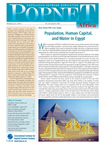 Dec.
2004: The
new POPNET is available online now
(PDF): No. 36, Autumn 2004
Dec.
2004: The
new POPNET is available online now
(PDF): No. 36, Autumn 2004
Content
° Population, Human Capital, and Water in Egypt
° Cairo Demographic Center (CDC)
° African Population and Health Research Center (APHRC)
° Former IIASA Researcher Joins UNECA
° Update from the Asian MetaCentre
° IIASA-AED-World Bank Project on Forecasting Human Capital
° Three IIASA PDE Case Studies in Africa
° The End of World Population Growth in the 21st Century
° How to Deal with Uncertainty in Population Forecasting?
 Nov.
2004: Some
error is inevitable when predicting fertility, mortality and migration,
the components of population change. At a meeting in 2002, jointly organized
with the Vienna
Institute of Demography, leading experts representing alternative
approaches to scenario analysis and stochastic population forecasting
offered their views on dealing with this uncertainty.Their collected
papers are now being reprinted in two special issues of International
Statistical Review. Contents
and Introduction (pdf).
Nov.
2004: Some
error is inevitable when predicting fertility, mortality and migration,
the components of population change. At a meeting in 2002, jointly organized
with the Vienna
Institute of Demography, leading experts representing alternative
approaches to scenario analysis and stochastic population forecasting
offered their views on dealing with this uncertainty.Their collected
papers are now being reprinted in two special issues of International
Statistical Review. Contents
and Introduction (pdf).
Aug. 2004: Sanderson, W.C. 2004. The SEDIM Model: Version 0.1. Laxenburg, Austria: International Institute for Applied Systems Analysis, IR-04-041.
This paper presents the SEDIM (Simple Economic Demographic Interaction Model) Model. The model illustrates how economic, demographic, and technological factors can be integrated into a rich, but still relatively simple framework that predicts rates of economic growth. SEDIM is designed to show the effects of demographic changes, including changes in the education composition of the population on economic performance ...
To download the comeplete report, please click here ...
July 2004: Wolfgang Lutz and Anne Goujon gave presentations at the meeting "Maps to the Future:Workshop on Making Education Projections for Policy", which was held at the Academy for Educational Development, Washington D.C., on July 12, 2004.
Download or view the sildes by Wolfgang Lutz and Anne Goujon
Conference: August 9-10
Population, Human Capital and Water
in Egypt
Please visit conference
website to view/download the presentations
Organizer(s): World Population Program
Wolfgang Lutz, Program Leader, lutz@iiasa.ac.at
Contact Person:
Marilyn Brandl , brandl@iiasa.ac.at
Phone: +43-2236-807 324
Fax: +43-2236-71313
Co-Organizer(s):
Cairo Demographic Center
Cairo Central Statistical Office
Social Research Center at the American University in Cairo
Institute of National Planning in Cairo
Vienna Institute of Demography
 Aug. 2004: Brian
O'Neill (POP and GGI)
Aug. 2004: Brian
O'Neill (POP and GGI)
Brian O'Neill (USA), research scholar at IIASA since 2002, is one of twenty-five
recipients of the first European
Young Investigator (EURYI) Award. The €1 million award will
allow him and his IIASA colleagues to carry out his proposed five year
project on "Demography, uncertainty, and learning in integrated
assessment models of climate change." The overall aims of the
research are to improve integrated assessment models of climate change
and to develop new methods of applying them to the climate change issue.
O'Neill's proposal was chosen from among 777 submissions by the Heads of the European
Research Organisations (EUROHORCs) in collaboration with the European
Science Foundation (ESF).
Some Press Releases:
- Brain-Gain: Award bringt Forscher nach Österreich, 30 July, APA Journal Forschung: Preisträger des ersten EURYI-Awards bekannt gegeben - US-Klimaforscher Brian O'Neill wird in Österreich arbeiten
- Neuer Preis bringt US-Forscher nach Österreich, 30 July, ORF on Science
- Europäische "Champions-League" herausragender
Jungforscher, 29 July, Der Standard
June 2004: The this year summer students of IIASA's Young Scientists Summer Program arrived! POP hosts Laura Sokka (University of Helsinki, Finland) and Sarah Staveteig (University of California, Berkeley). For mor information on POP's YSSPers please click here...
March 2004: Book presentation at the United Nations,
New York, USA (March
25, 2004)
Dr. Wolfgang Lutz and Dr. Warren Sanderson presented the book "The
End of World Population Growth in the 21st Century: New Challenges for Human
Capital Formation and Sustainable Development" (edited by Wolfgang
Lutz, Warren Sanderson, and Sergei Scherbov, and published by Earthscan, London,
2004)
at the United Nations Headquarters on the occasion of the meeting of the UN
Commission of Population and Development. The presentation was hosted by
the Austrian Mission.
 March
2004: Wolfgang
Lutz, Warren C. Sanderson, and Sergei Scherbov, (Eds.). 2004. The End
of World Population Growth in the 21st Century: New Challenges for Human
Capital
Formation and Sustainable Develpment.
March
2004: Wolfgang
Lutz, Warren C. Sanderson, and Sergei Scherbov, (Eds.). 2004. The End
of World Population Growth in the 21st Century: New Challenges for Human
Capital
Formation and Sustainable Develpment.
London: Earthscan in association with IIASA.
"This book ... will be widely read and highly influential among demographers,
economists, and other modelers of long-term dynamic social processes" says
Jeffrey Sachs, Director of the Earth Institute at Columbia University and Special
Advisor to UN Secretary General Kofi Annan, referring to the new book edited
by Wolfgang Lutz, Warren Sanderson and Sergei Scherbov of IIASA's World Population
Program. Hans van Ginkel, Rector of the UN University calls it "... the
most innovative book on population change I have ever seen – a must for
all policy and decision makers." More
quotations and ordering information (pdf), and more information about the
probabilistic population projections click
here ...
 March
2004: The
Secretary-General of the United Nations has appointed Gui-Ying CAO of
IIASA’s Population Program to the UN
Committee for Development Policy (CDP) for the term 2004–2006. The
committee is a subsidiary body of the Economic and Social Council (ECOSOC),
which is responsible for formulating policy recommendations to UN member
states and to the UN system on matters pertaining to development.
March
2004: The
Secretary-General of the United Nations has appointed Gui-Ying CAO of
IIASA’s Population Program to the UN
Committee for Development Policy (CDP) for the term 2004–2006. The
committee is a subsidiary body of the Economic and Social Council (ECOSOC),
which is responsible for formulating policy recommendations to UN member
states and to the UN system on matters pertaining to development.
Jan. 2004: The World
Population Program Research Plan for the year 2004 is now
available (in PDF format), extracted from the IIASA
Research Plan 2004, pp. 71-79. For more details on ongoing and past
research follow the navigation menu on the left.
World Population Program Home Page
Dec. 2003: Publication of an article "Long-term population decline in Europe: The relative importance of tempo effects and generation length" (in Population and Development Review 29(4):699-707), by J. Goldstein (Princeton University), W. Lutz, and S. Scherbov. This article is a follow-up to the recent article in Science Magazine.
Oct. 2003: Visit to IIASA by Alex Ezeh, Executive Director of the African Population and Health Research Center (APHRC) in Nairobi, a high quality pan-African research institute on population. Agreement of collaboration in which APHRC will serve as POP's regional partner in Africa (similar to the Asian MetaCentre in Singapore)
 Sep.
2003. Dramatic population aging may threaten Europe's social and
economic well-being. To help policymakers respond to this predicament,
IIASA's
World Population Program
(POP) has recently established collaboration with the Vienna
Institute of Demography (of the Austrian Academy of Sciences) and
other European demographic institutes. Read the new issue of POPNET
(pdf), to learn what POP project leader Wolfgang Lutz and his colleagues
say about the European demographic challenge and the work of this alliance.
(Posted September 4th, 2003)
Sep.
2003. Dramatic population aging may threaten Europe's social and
economic well-being. To help policymakers respond to this predicament,
IIASA's
World Population Program
(POP) has recently established collaboration with the Vienna
Institute of Demography (of the Austrian Academy of Sciences) and
other European demographic institutes. Read the new issue of POPNET
(pdf), to learn what POP project leader Wolfgang Lutz and his colleagues
say about the European demographic challenge and the work of this alliance.
(Posted September 4th, 2003)
Sep. 16, 2003: The POP Program was invited to give a seminar at
the World Bank in Washington,
D.C. on the IIASA method of projecting human capital formation (Speakers:
W. Lutz, A. Goujon, and A. Wils).
Given the World Bank's new priority on education and the fact that IIASA
has developed the only multi-state method for projecting the population
by level of education, this may be the beginning of intensive future collaboration.
More on projecting human capital...
Sep. 2003: The population project developed a new set of four
global population projections for use in the Millennium
Ecosystem Assessment, a large international scientific effort to
assess the current conditions of and future outlook for global ecosystem
goods
and services. The population scenarios were derived using a newly
developed methodology for designing individual scenarios based on the
Program's existing probabilistic projections for the world.
Contact: Brian O'Neill (oneill@iiasa.ac.at).
Click here to receive more information on the population
projections.
Aug. 13-20, 2003: 54th
Session of the International Statistical Institute (ISI) in Berlin:
A special session was organized by W. Lutz on "How to deal with uncertainty
in population forecasting?" based on papers resulting from a joint
IIASA/Austrian Academy of Sciences workshop in December 2002. The papers
will be published in special issues of the International
Statistical Review (the official ISI Journal) in March and August
2004.
In Berlin Wolfgang Lutz also spoke at an ISI press conference on current demographic challenges in Europe, which resulted in extensive coverage including the New York Times (Aging Europe Finds Its Pension Is Running), International Herald Tribune (The looming clash of generations) and a number of major Asian newspapers.
March 2003:
 "Europe's Population at a Turning
Point" by project researchers Wolfgang Lutz, Brian O'Neill,
and Sergei Scherbov, appeared in the March 28th issue of Science
Magazine (Vol. 299, pp. 1991-1992). The study suggests that the current
trend in Europe toward later childbearing could exacerbate future population
aging and contribute to a future decline in population size. News
release. To download the summary and/or full text click
here...
"Europe's Population at a Turning
Point" by project researchers Wolfgang Lutz, Brian O'Neill,
and Sergei Scherbov, appeared in the March 28th issue of Science
Magazine (Vol. 299, pp. 1991-1992). The study suggests that the current
trend in Europe toward later childbearing could exacerbate future population
aging and contribute to a future decline in population size. News
release. To download the summary and/or full text click
here...
World Population Program Home Page
 Global
Science Panel Report released at WSSD in Johannesburg, 31 August 2002:
The IIASA –
IUSSP – UNU Global Science Panel on Population and Environment
has completed for the Johannesburg Summit a scientific assessment of the
role of population in sustainable development. Population
in Sustainable Development: Analyses, Goals, Actions, Realities is
now being presented to the delegates. In addition to the panel's statement,
the document includes background material on past goals and current trends.
Global
Science Panel Report released at WSSD in Johannesburg, 31 August 2002:
The IIASA –
IUSSP – UNU Global Science Panel on Population and Environment
has completed for the Johannesburg Summit a scientific assessment of the
role of population in sustainable development. Population
in Sustainable Development: Analyses, Goals, Actions, Realities is
now being presented to the delegates. In addition to the panel's statement,
the document includes background material on past goals and current trends.
 Wils,
Annababette (Ed.) 2002. Population-Development-Environment
in Mozambique. Laxenburg, Austria: International Institute for Applied
Systems Analysis, Interim Report IR-02-049, 136p.
Wils,
Annababette (Ed.) 2002. Population-Development-Environment
in Mozambique. Laxenburg, Austria: International Institute for Applied
Systems Analysis, Interim Report IR-02-049, 136p.
The report
is available in PDF format
(posted August 2002)
 2002:
Members of the IIASA – IUSSP – UNU Global Science Panel
on Population and Environment have published a note to the editors of
Nature stressing
"If we do not put the human population at the core of the sustainable
development agenda, our efforts to improve human well-being and preserve
the quality of the environment will fail." Signatories include 8
IIASA scientists as well as Maurice Strong and Nafis Sadik. See full
statement (pdf) on the Global
Science Panel home page.
2002:
Members of the IIASA – IUSSP – UNU Global Science Panel
on Population and Environment have published a note to the editors of
Nature stressing
"If we do not put the human population at the core of the sustainable
development agenda, our efforts to improve human well-being and preserve
the quality of the environment will fail." Signatories include 8
IIASA scientists as well as Maurice Strong and Nafis Sadik. See full
statement (pdf) on the Global
Science Panel home page.
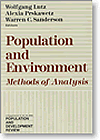 March
2002: Wolfgang Lutz, Alexia Prskawetz, and Warren C. Sanderson (Eds.)
2002. Population and Environment: Methods of Analysis. A supplement to
Vol. 28, 2002 of Population and Development Review.
March
2002: Wolfgang Lutz, Alexia Prskawetz, and Warren C. Sanderson (Eds.)
2002. Population and Environment: Methods of Analysis. A supplement to
Vol. 28, 2002 of Population and Development Review.
How does the human population affect the natural environment and vice versa? Increasing research in this field calls for more appropriate analytical methods. In this first systematic treatment, the contributors — demographers, other social scientists, and environmental scientists — describe and critically examine key concepts and analytical approaches, both in theoretical terms and through examples and case studies. (Posted March 2002)
World Population Program Home Page
 The
article on THE END OF WORLD POPULATION
GROWTH that appeared in the 02 August 2001 issue of Nature has
received wide press attention. Nature made the article its Featured Article
of the week.
The
article on THE END OF WORLD POPULATION
GROWTH that appeared in the 02 August 2001 issue of Nature has
received wide press attention. Nature made the article its Featured Article
of the week.
Population project leader Wolfgang Lutz and colleagues Warren Sanderson
of the State University of New York at Stony Brook and Sergei Scherbov
of the University of Groningen find it highly probable that world population
will reach a peak during this century and then start to decline. Over
the coming decades ther
e will be a growing demographic divide. For many of today's poorest countries, population growth, reproductive health, and poverty will still be pressing issues. In more and more countries, including China, population aging will pose a major challenge. (posted August 2001). Nature 412: 543 - 545 (2001) © Macmillan Publishers Ltd.: includes supplementary information, methods, and references, http://www.nature.com/cgi-taf/DynaPage.taf?file=/nature/journal/v412/n6846/full/412543a0_fs.html. IIASA Reprint Research Report (RR-01-012) can be ordered for a handling charge of US$12 at http://www.iiasa.ac.at/cgi-bin/pubsrch?RR01012
July 2001: Global Science Panel on Population and Environment:
IIASA, IUSSP and UNU have recently launched a Global Science Panel on
Population and Environment to assess the role of the population variable
in sustainable development and to build a bridge between the Rio and Cairo
processes. Nafis Sadik and Maurice Strong serve as patrons of this panel,
which held its first meeting at NIDI (Netherlands Interdisciplinary Demographic
Institute) on July 16, 2001.
The panel will produce a policy statement for wide distribution in the
preparatory process for the Johannesburg Summit on Sustainable Development
and hold a scientific meeting on Population in Sustainable Development
at IIASA on March 21-23, 2002. (Posted July 31st, 2001.)
June 2001: Lutz, Wolfgang and Anne Goujon. 2001. The World's Changing Human Capital Stock: Multi-State Population Projection by Educational Attainment. In Population and Development Review 27(2):323-339, June 2001.
 June 2001: Population
is the focus of the newest Options
magazine (pdf). In an interview, Program Leader Wolfgang Lutz discusses
ongoing work toward a general concept of population balance, which combines
concerns about population growth and population aging. You'll also find
results of recent PDE (population-development-environment) case studies
on Namibia, Botswana and Mozambique, based on extensive modeling of
the
sustainable development implications of HIV/AIDS, including consideration
of the cost of AIDS medication. Also in this issue: summaries of the
first
global population projections by level of education.
June 2001: Population
is the focus of the newest Options
magazine (pdf). In an interview, Program Leader Wolfgang Lutz discusses
ongoing work toward a general concept of population balance, which combines
concerns about population growth and population aging. You'll also find
results of recent PDE (population-development-environment) case studies
on Namibia, Botswana and Mozambique, based on extensive modeling of
the
sustainable development implications of HIV/AIDS, including consideration
of the cost of AIDS medication. Also in this issue: summaries of the
first
global population projections by level of education.
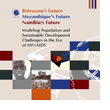 Feb. 2001: CD-ROM / Website: AFRICA IN THE ERA OF HIV/AIDS: Botswana's
Future, Mozambique's Future, Namibia's Future: Modeling Population and
Sustainable Development - Challenges in the Era of HIV/AIDS.
Feb. 2001: CD-ROM / Website: AFRICA IN THE ERA OF HIV/AIDS: Botswana's
Future, Mozambique's Future, Namibia's Future: Modeling Population and
Sustainable Development - Challenges in the Era of HIV/AIDS.
Compiled by a research team lead by W. Lutz.
Publications
Release, and visit the web version of the CD-ROM, www.iiasa.ac.at/Research/POP/pde/
World Population Program Home Page
Responsible for this page: Suchitra Subramanian
Last updated:
05 Sep 2011
Phone: (+43 2236) 807 0
Copyright © 2009-2011 IIASA

